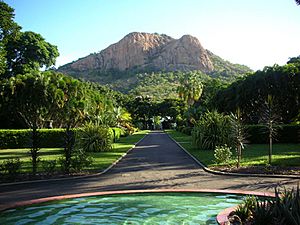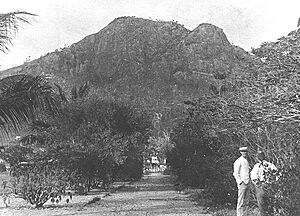Queens Gardens, Townsville facts for kids
Quick facts for kids Queens Gardens, Townsville |
|
|---|---|

Queens Gardens, 2009
|
|
| Location | Paxton Street, North Ward, City of Townsville, Queensland, Australia |
| Design period | 1824 - 1841 (convict settlement) |
| Official name: Queens Gardens | |
| Type | state heritage (landscape, built) |
| Designated | 14 August 2008 |
| Reference no. | 601765 |
| Significant period | 1870- |
| Significant components | garden - rock / rockery, garden - rainforest, garden/grounds, garden - ornamental/flower, garden - layout, garden - bed/s, garden furniture/seating, garden - native |
| Lua error in Module:Location_map at line 420: attempt to index field 'wikibase' (a nil value). | |
Queens Gardens is a beautiful, historic park in Townsville, Queensland, Australia. It's a large botanic garden located at the bottom of Castle Hill. Many people consider it Townsville's best park. It was added to the Queensland Heritage Register on 14 August 2008 because of its special history and beauty.
The gardens officially started in 1870. Back then, they were called the Botanical Gardens Reserve. They were set up to help the town grow food and develop farming. The original area was about 100 acres. They planted many different kinds of plants, including cocoa, African oil palms, and mangoes. Some of the hoop pines and black beans (Castanospermum australe) planted long ago are still there today. They might even be the oldest cultivated trees of their kind in Australia!
Over time, this busy garden changed into a fun park for everyone to enjoy. During World War II, it was even used as a military base for American soldiers. In 1959, Mr. Alan Wilson, a parks expert, redesigned the gardens. Today, the gardens are much smaller, about one-tenth of their original size. This happened because the city needed space for sports fields and new homes.
Contents
The History of Queens Gardens
Queens Gardens is what's left of Townsville's first large botanical garden. It was called the Botanical Gardens Reserve and was created on June 14, 1870. It was originally 100 acres big, but now it's about 10 acres.
Why Were They Called Queens Parks?
Many botanic gardens in the 1800s were known as Queens Parks. This was to honor Queen Victoria, who was the Queen of the British Empire for a long time (1836-1901). These parks were very popular and were seen as the most important park in a town.
How the Gardens Changed Over Time
From the very beginning, the gardens in Townsville have changed a lot. Their size, design, and even the types of plants grown there have evolved. At first, they were like a science lab for plants. They focused on:
- Botany as science: Learning about plants.
- Economic botany: Growing plants that could help the local economy.
- Education: Teaching people about plants and gardening.
- Ornamental botany: Making the gardens beautiful.
In the 1800s, there was a lot of interest in understanding the natural world. People wanted to identify and grow new plants. Botanic gardens helped with this by testing plants that could be useful for farming or business. They also made the towns look nicer.
A Global Network of Gardens
By the late 1800s, many botanic gardens were connected around the world. The Royal Botanic Gardens, Kew in London was the main center for plant information. Gardens were set up in most big towns in Queensland, including Townsville.
How the Gardens Shrank
The original garden was very large and close to the city center. Because of this, parts of the land were used for other public needs.
- In 1886, the Townsville Grammar School was given 10 acres of the garden land.
- In 1887, Burke Street was extended right through the park.
- Other parts were used for a jail (1885) and sports fields (1899).
- By 1915, the garden was only 35 acres.
- In 1948, more land was used for a bowling club and recreation. This reduced the gardens to their current size of 10 acres.
Early Garden Keepers and Funding
At first, the Townsville Council didn't get much money from the government for the gardens. This made it hard to get them started. In 1878, William Anderson became the first "curator," or garden manager. He lived in a small house on site until he retired in 1934.
Anderson didn't have money to buy plants. So, in 1880, the government took control of the gardens from the Council and appointed special trustees. One of these trustees was Thomas Allen Gulliver jnr. He had collected plants for Baron Ferdinand Von Mueller, a famous botanist from Melbourne.
With the new trustees, the gardens got more funding. They became a popular spot for picnics and concerts. Plants were sent from other gardens, like those in Brisbane and Rockhampton.
However, money was still tight. The curator had to charge fees for public events. But William Anderson still managed to send young trees to schools and groups across North Queensland. He also exchanged plants with other botanic gardens in Australia.
Plants for the Economy
Anderson managed Queens Gardens as a place to test tropical plants that could be useful for the economy. Some early plants included grape vines, cocoa nut trees, coffee, breadfruit, and mangoes. They also planted timber trees like mahogany and hoop pines. Many tropical trees were planted around the edges of the gardens, including figs and black beans.
From Science to Pleasure Park
In 1893, the Council took over the gardens again. The gardens continued to grow and experiment with plants. But by the late 1800s, people wanted the gardens to be more of a "pleasure ground." They wanted a beautiful place to relax. In 1898, the Council decided to manage the gardens as a park, not just a scientific botanical garden.
The gardens became very popular in the 1880s and 1890s. People held tea parties and special events there. Its closeness to the Townsville General Hospital also meant many visitors.
Damage from Cyclones
A special plant house, called a bush-house, was built in 1889. But it was destroyed by Cyclone Leonta in March 1903. The curator's cottage was also badly damaged.
World War II and Redesign
During World War II, Queens Park was used as a military base for Australian and American soldiers. Tents and temporary buildings were set up, but the large trees were kept safe.
In 1959, the Council hired Alan Wilson to redesign the gardens. He was a landscape architect from Brisbane. At this time, the park was renamed Queens Gardens to honor Queen Elizabeth II.
Jim Thomas took over from Alan Wilson in 1968. He helped save many old trees after Cyclone Althea caused a lot of damage in 1971.
Today, the gardens are still a popular place for weddings and big events like the annual Eco Fiesta. The design from 1959 is mostly still the same.
Exploring Queens Gardens Today
Townsville's Queens Gardens has a formal design from the mid-1900s. It still has some older features from the Victorian era. These include open grassy areas, a small animal section, and pretty flower beds. Castle Hill makes a beautiful background for the gardens.
Trees and Plants to See
The gardens have many different types of plants. Around the edges, you'll find straight rows of tropical rainforest trees planted in 1887.
- On the eastern side, there's an avenue of black bean trees (Castanospermum australe). Some of these are original plantings!
- Along the southern side, there's a "rainforest walk." Here you'll see interesting trees like the mahogany tree from the West Indies (Swietenia mahagoni), large banyan trees (Ficus retusa), and rain trees (Samanea saman).
- The rainforest walk has about 166 different kinds of trees, shrubs, and groundcovers. These plants are typical of the dry rainforests in North Queensland.
Paths and Entrances
You can enter the gardens from Paxton Street (north-west gate) or Gregory Street (south-west gate). Inside, there's a path system that looks like a "T." The main path leads you from the formal entrance towards Castle Hill.
Special Features
- Central Fountain: Where the main paths cross, you'll find a fountain surrounded by a vine archway and seating.
- Fruit Trees: Near the fountain, there's a big mango tree (Mangifera indica) and governors plum trees (Flacourtia jangomas).
- Aviaries: In the northern part of the gardens, there are aviaries (bird enclosures). They are very popular and house different native parrots and farm birds.
- Curator's Cottage: Behind the aviaries is the old cottage where the garden manager used to live.
- Rose Garden: Past a herb garden, you'll find a quiet rose garden. It has columns from the original Townsville Town Hall. This area looks like a formal garden from the early 1900s.
- Open Lawns: The south-eastern part of the garden has open grassy areas and shady trees. Many of these trees are very old and important, like the hoop pine (Araucaria cunninghamii), oil palm (Elaeis guineensis), and tamarind (Tamarindus indica).
- Playground: There's a small playground in the far northern corner.
- Other Areas: You can also find an Events Lawn, a Herb Society's garden, a perennial border (flowers that come back every year), two hedged mazes, a Frangipani collection, and the black bean avenue. The aviary has peacocks, lorikeets, and sulfur-crested cockatoos.
The gardens were damaged by Cyclone Yasi, but they are recovering well. They are a great place for outdoor weddings and other events.
Why Queens Gardens is Important (Heritage Listing)
Queens Gardens was added to the Queensland Heritage Register on 14 August 2008 for a few key reasons:
Showing Queensland's History
Queens Gardens shows how botanic gardens developed in regional cities in Queensland. It has always been a place for:
- Learning about local plants and their possible uses.
- Sharing plant knowledge and seeds with other gardens.
- Providing a beautiful and educational place for people to enjoy.
As part of Queensland's network of botanic gardens, Queens Gardens has been connected to a global network, with Kew in London as a main starting point.
A Great Example of a Botanic Garden
The gardens are a good example of a large tropical public botanic garden that has changed over time. It has kept its main design ideas and features, making it a clear and special type of place.
Its Beauty and Feel
The mix of old trees, open lawns, and well-kept gardens creates a peaceful place near the city center. The gardens offer a wonderful experience for your senses – you can see, hear, and smell the beauty of the place. Castle Hill in the background makes the views even more amazing.
A Special Place for the Community
The gardens were created for both science and fun, and they continue to be a central spot for community events. They are important to the community because they have been a popular place for public recreation for a very long time.
Images for kids
See also
 In Spanish: Jardines Queens de Townsville para niños
In Spanish: Jardines Queens de Townsville para niños





